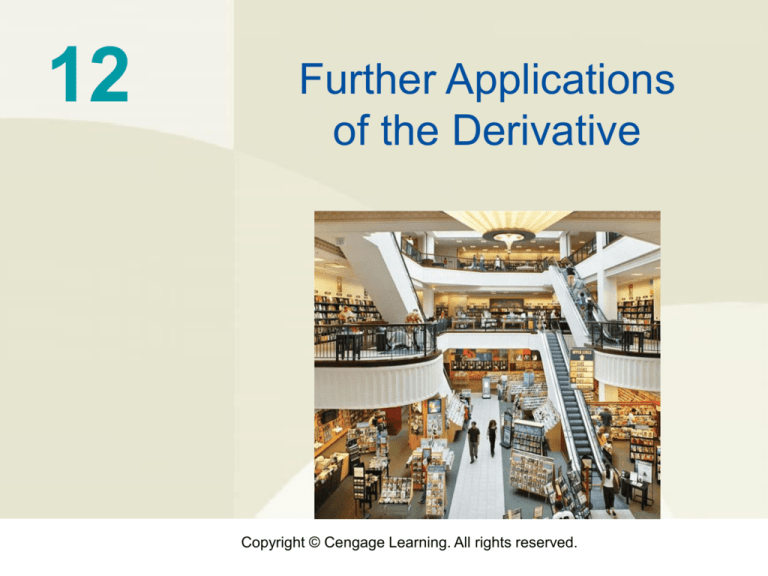
12
Further Applications
of the Derivative
Copyright © Cengage Learning. All rights reserved.
12.6
Elasticity
Copyright © Cengage Learning. All rights reserved.
Elasticity
You manufacture an extremely popular brand of sneakers
and want to know what will happen if you increase the
selling price.
Common sense tells you that demand will drop as you
raise the price.
But will the drop in demand be enough to cause your
revenue to fall? Or will it be small enough that your revenue
will rise because of the higher selling price?
3
Elasticity
For example if you raise the price by 1%, you might suffer
only a 0.5% loss in sales.
In this case, the loss in sales will be more than offset by the
increase in price and your revenue will rise.
In such a case, we say that the demand is inelastic,
because it is not very sensitive to the increase in price.
On the other hand, if your 1% price increase results in a
2% drop in demand, then raising the price will cause a drop
in revenues.
4
Elasticity
We then say that the demand is elastic because it reacts
strongly to a price change.
We can use calculus to measure the response of demand
to price changes if we have a demand equation for the item
we are selling.
We need to know the percentage drop in demand per
percentage increase in price.
This ratio is called the elasticity of demand, or price
elasticity of demand, and is usually denoted by E.
5
Elasticity
Let’s derive a formula for E in terms of the demand
equation.
Assume that we have a demand equation
q = f(p)
where q stands for the number of items we would sell (per
week, per month, or what have you) if we set the price per
item at p.
Now suppose we increase the price p by a very small
amount, p.
6
Elasticity
Then our percentage increase in price is (p/p) × 100%.
This increase in p will presumably result in a decrease in
the demand q.
Let’s denote this corresponding decrease in q by –q (we
use the minus sign because, by convention, q stands for
the increase in demand).
Thus, the percentage decrease in demand is
(–q/q) × 100%.
7
Elasticity
Now E is the ratio
so
Canceling the 100%s and reorganizing, we get
8
Elasticity
Price Elasticity of Demand
The price elasticity of demand E is the percentage rate of
decrease of demand per percentage increase in price. E is
given by the formula
We say that the demand is elastic if E > 1, is inelastic if
E < 1, and has unit elasticity if E = 1.
9
Elasticity
Quick Example
Suppose that the demand equation is q = 20,000 – 2p
where p is the price in dollars.
Then
If p = $2,000, then E = 1/4, and demand is inelastic at this
price.
If p = $8,000, then E = 4, and demand is elastic at this
price.
10
Elasticity
If p = $5,000, then E = 1, and the demand has unit
elasticity at this price.
In the above example, if p = $2,000 then the demand would
drop by only
for every 1% increase in price.
To see the effect on revenue, we use the fact that, for small
changes in price,
Percentage change in revenue ≈ Percentage change in
price + Percentage
change in demand
11
Elasticity
Thus, the revenue will increase by about 3/4%. Put another
way:
If the demand is inelastic, raising the price increases
revenue.
12
Elasticity
On the other hand, if the price is elastic (which ordinarily
occurs at a high unit price), then increasing the price
slightly will lower the revenue, so:
If the demand is elastic, lowering the price increases
revenue.
The price that results in the largest revenue must therefore
be at unit elasticity.
13
Example 1 – Price Elasticity of Demand: Dolls
Suppose that the demand equation for Bobby Dolls is given
by q = 216 – p2, where p is the price per doll in dollars and
q is the number of dolls sold per week.
a. Compute the price elasticity of demand when p = $5 and
p = $10, and interpret the results.
b. Find the ranges of prices for which the demand is elastic
and the range for which the demand is inelastic
c. Find the price at which the weekly revenue is maximized.
What is the maximum weekly revenue?
14
Example 1 – Solution
a. The price elasticity of demand is
Taking the derivative and substituting for q gives
When p = $5,
15
Example 1 – Solution
cont’d
Thus, when the price is set at $5, the demand is
dropping at a rate of 0.26% per 1% increase in the price.
Because E < 1, the demand is inelastic at this price, so
raising the price will increase revenue.
When p = $10,
16
Example 1 – Solution
cont’d
Thus, when the price is set at $10, the demand is
dropping at a rate of 1.72% per 1% increase in the price.
Because E > 1, demand is elastic at this price, so raising
the price will decrease revenue; lowering the price will
increase revenue.
b. and c. We answer part (c) first. Setting E = 1, we get
17
Example 1 – Solution
cont’d
Thus, we conclude that the maximum revenue occurs
when
We can now answer part (b): The demand is elastic
when p > $8.49 (the price is too high), and the demand is
inelastic when p < $8.49 (the price is too low).
Finally, we calculate the maximum weekly revenue,
which equals the revenue corresponding to the price of
$8.49:
R = qp
18
Example 1 – Solution
cont’d
= (216 – p2)p
= (216 – 72)
= 144
≈ $1,222.
19









